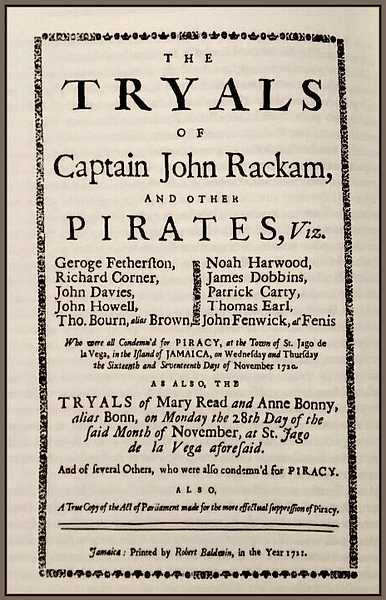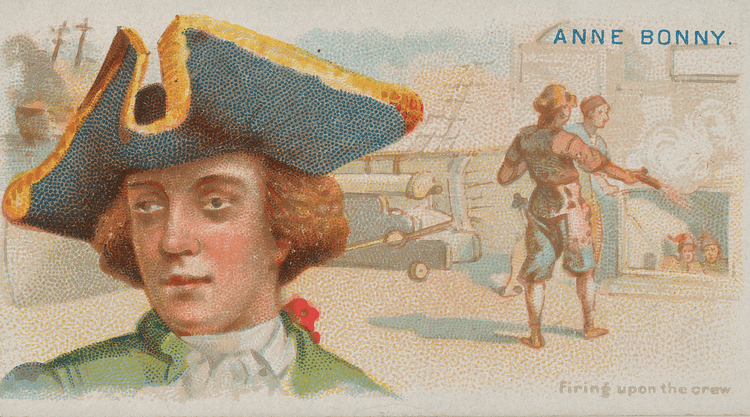
Anne Bonny (also Bonney) was an Irish-born pirate who briefly operated in the waters around the Bahamas before her capture by the Jamaican authorities in 1720. As partner to the English pirate John Rackham, aka ‘Calico Jack’, Bonny dressed as a man in battle and fought courageously in her last stand against the authorities while her fellow male pirates hid below decks.
Bonny was one of only two female pirates of the so-called Golden Age of Piracy who gained infamy, the other being her friend and crewmate Mary Read (sometimes spelt with a final ‘e’). Both were captured, tried, and sentenced to be hanged for piracy, but they had their executions delayed because they were each pregnant. While Read died in prison of fever, the ultimate fate of Anne Bonny can only be speculated.
Early Life
Anne Cormac was born in Ireland, probably sometime between 1690 and 1700. When still a child, Anne’s family relocated to a plantation in South Carolina. As a child, her mother dressed her as a boy, which was an ominous indicator of her future career, but it did have a purpose since a family will required the infant to be male. Anne's mother died, and she ran her father's household, but not for long. Anne left her father and, against his wishes, married James Bonny, a pirate who gave up his life of crime following the offer of a pardon from Woodes Rogers (1679-1732), the governor of the Bahamas, where the couple settled. James now earned a living as a fisherman and as an informant on his former pirate colleagues. However, the lure and romance of the sea would ensure that Bonny did not stay a landlubber for long.
Anne Bonny & ‘Calico Jack’
Anne Bonny gained her notoriety when she sailed off with the English pirate John Rackham (d. 1720), whose nickname was ‘Calico Jack’ because of his preference for plain cotton clothes rather than the often outlandish silks other pirates preferred. Bonny and Rackham had met on Providence Island (Nassau) in the Bahamas in the spring of 1719, and they became lovers. Rackham was then enjoying some leisure time onshore, having received a pardon from the governor. Anne left her husband James and, in August 1719, sailed with Rackham in the William, a sloop they had captured in the port of New Providence. On 5 September, Governor Rogers issued a warrant for the arrest of Rackham which listed his suspected crew. Included in the names is Anne Bonny whose alias is noted as Ann Fulford.
Rackham and Bonny, with their total crew of fewer than 20 men and a limited number of captures, were relatively small-time pirates compared to some of the other figures of the Golden Age of Piracy. Following one capture, another woman was added to the pirate crew, Mary Read. Rackham's crew certainly made for an unusual band of renegades at a time when women at sea were a real rarity. Indeed, many pirate captains created articles that strictly prohibited women and young boys on board their ships to avoid any squabbles over sexual favours or predatory behaviour. As the historian J. Rogozinski notes, in the case of Bonny and Read, "the pirates tolerated the women because they made themselves available to everyone in Rackham’s small crew" (33).
Both Bonny and Read wore men’s clothes at sea and are described as wearing handkerchiefs around their heads (which although now commonly thought to have been worn by most pirates, were actually rare, or at least undocumented amongst men). Testimony at their trials revealed that Bonny and Read only dressed as men when in battle when they usually fought with pistols. Indeed, the romantic suggestion often presented in popular pirate histories that they disguised themselves as men all of the time tests the imagination given the cramped life on board ships, even if there are historical cases of women sometimes fooling their peers on board merchant ships of the period.
The mixed pirate crew led by Rackham managed to evade the authorities, and they plundered the merchant ships in the waters around the Bahamas and a wide arc of shipping routes from Bermuda to Hispaniola, taking such unglamorous cargoes as tobacco and peppers. Bonny and Rackham had a child, but this was abandoned in Cuba where Bonny had spent the latter part of her pregnancy.
Bonny’s Capture
In November 1720, while anchored off the western tip of Jamaica, Rackham and Bonny’s ship suffered a surprise attack from the Tyger, sent by the new governor of the island, Sir Nicholas Lawes, and commanded by Jonathan Barnet. The pirates, numbering 18 according to Lawes' report to London, cut their anchor cable and made a hasty departure, but they were overhauled during the night and boarded. Rackham and the rest of the crew hid below decks - they were most likely all drunk - and only Bonny, Read, and one other man put up any resistance against Barnet’s men. They were, nevertheless, captured and taken to Spanish Town (at the time called St. Jago de la Vega) on Jamaica for trial.
Trial & Aftermath
The two women were to be tried separately from the men on 28 November, but both groups faced the same terrible charge: piracy. The trial notice, circulated a few days after, also notes that Bonny’s alias was ‘Bonn’. The documents from this trial reveal interesting points about the two female pirates’ past and their characters. Bonny and Read were described by one witness, Thomas Dillon, as "both profligate, cursing and swearing much, and very ready and willing to do anything on board" (Cordingly, 111). He also recorded that Bonny was wielding a pistol when apprehended. The witness Dorothy Thomas gave the following description of an attack, which confirmed beyond doubt that Bonny and Read were willing members of the pirate crew:
…the two women, prisoners at the bar, were then on board the said sloop, and wore mens jackets, and long trousers, and handkerchiefs about their heads; and that each of them had a machet and pistol in their hands, and cursed and swore at the men, to murder the deponents; and that they should kill her, to prevent her coming against them; and the deponent further said, that the reason of her knowing and believing them to be women then was by the largeness of their breasts.
(Cordingly, 64)
Another witness, this time a Frenchman speaking through an interpreter, confirmed the habit of Bonny and Read of changing their clothes for battle: "when they saw any vessel, gave chase, or attacked, they wore men’s clothes, and at other times, they wore women’s clothes" (Ibid).
All parties pleaded not guilty to the charges of piracy, despite the obvious evidence against them and the testimony of witnesses from not one but several ships they had plundered. No defence was given, and all were found guilty. Rackham was sentenced to be hanged, but Bonny was unsympathetic, reportedly stating, "If you had fought like a man you wouldn’t be hanged like a dog" (Downie, 193). As was customary, Rackham’s body was hung in a cage to rot in the open air as a warning to others who fancied a life of piracy.

Anne Bonny and Mary Read were also sentenced to be hanged, but both women received a reprieve upon revealing to the court that each was pregnant. The laws at the time forbade the execution of a pregnant woman - the unborn child was innocent, if not the mother - and so Bonny and Read were temporarily allowed to live. Examinations were made of both women to ensure they were telling the truth. Read was recorded in the Parish Register for the district of St. Catherine as having died in a Jamaican prison of fever in 1721, she was buried on 28 April.
What happened next to Bonny is not known, but she may have escaped prison or been pardoned. However she achieved her freedom, one legend of her last years is that she became the mistress of Robert Fenwick. Yet another former pirate, Fenwick had once plundered the merchants of the Red Sea, but he now lived a quiet and comfortable life in Fenwick Castle, a structure he had built near Charleston, South Carolina. The restless Bonny then ran away with another man but was persuaded to return to Fenwick who saw to it that his love rival was hanged. As an alternative to this story, Anne may have died in Jamaica in December 1733 if an entry in parish records noting the death of one ‘Ann Bonny’ does indeed refer to the infamous pirate.
The Anne Bonny of Daniel Defoe
Anne Bonny was the subject of a biography alongside many other pirates in Daniel Defoe’s celebrated work, the General History of the Robberies and Murders of the Most Notorious Pyrates, compiled in the 1720s. The work was credited to a Captain Charles Johnson on its title page, but this is perhaps a pseudonym of Defoe’s (although scholars are still debating the issue and Charles Johnson may have been a real, if entirely unknown pirate expert). A mix of fact and fiction - with no indication where one runs into the other - the book was a smash hit and has defined how pirates have been portrayed ever since. The author did clearly have access to official papers, records of trials, and journalistic contemporary accounts, and many statements have proven to be factual when corroborated with historical records. However, there are also countless exaggerations and pure inventions such as private conversations and speeches seemingly repeated ad verbatim. It is perhaps significant that Defoe was both a successful journalist and author, in other words, he knew exactly how to blend fact and fiction for maximum literary effect.
Defoe’s titillating biography of the female pirate has Anne born near Cork in Ireland, the illegitimate daughter of a lawyer, the mother being one of his maids. Wishing to keep his illegitimate daughter with him, Anne’s father dressed her as a boy and pretended she was an apprentice clerk. Circumstances conspired to oblige Anne’s father, the maid, and child to emigrate to South Carolina where he found success as a plantation owner. Anne, then, was well set up for a comfortable life, but she rejected this in favour of adventure at sea with the pirate James Bonny. The pair married and settled in the Bahamas after receiving a pardon from Governor Rogers. Anne is restless and sleeps around a bit before settling on Jack Rackham. She then leaves her husband to pursue a life of crime with Rackham in a stolen sloop.
Defoe insists that Anne fooled Rackham’s crew into thinking she was a man, despite the pregnancy that necessitated a stopover in Cuba. After Cuba, Mary Read joins the Rackham crew, and Defoe ramps up the shock factor of his story (and further tests the credibility of his readers) by having Anne attempt to seduce Read, who is also disguising herself as a man. Apparently, Anne thought Read a rather pretty boy, but Read reveals that she is a woman to Bonny and, to avoid his jealousy of the two women’s friendship, also to Rackham. The rest of the crew are left in the dark as to the sex of their two crewmates. Bonny is then caught, tried, and reprieved in the manner mentioned above, with Defoe ending the story with the note that what became of Bonny is unknown except that she was not executed. As with pirates like Edward Teach, aka Blackbeard, Defoe’s extravagant character portrait of Anne Bonny would inspire, colour, and prejudice many subsequent writers of novels, histories, and films ever after.








